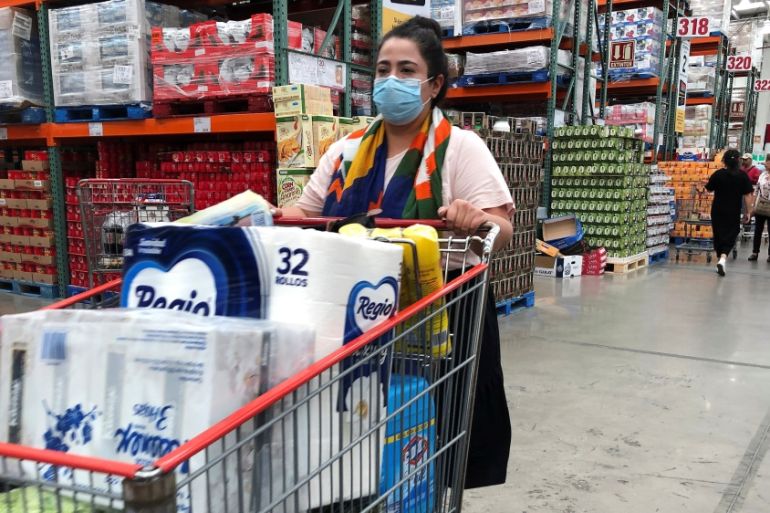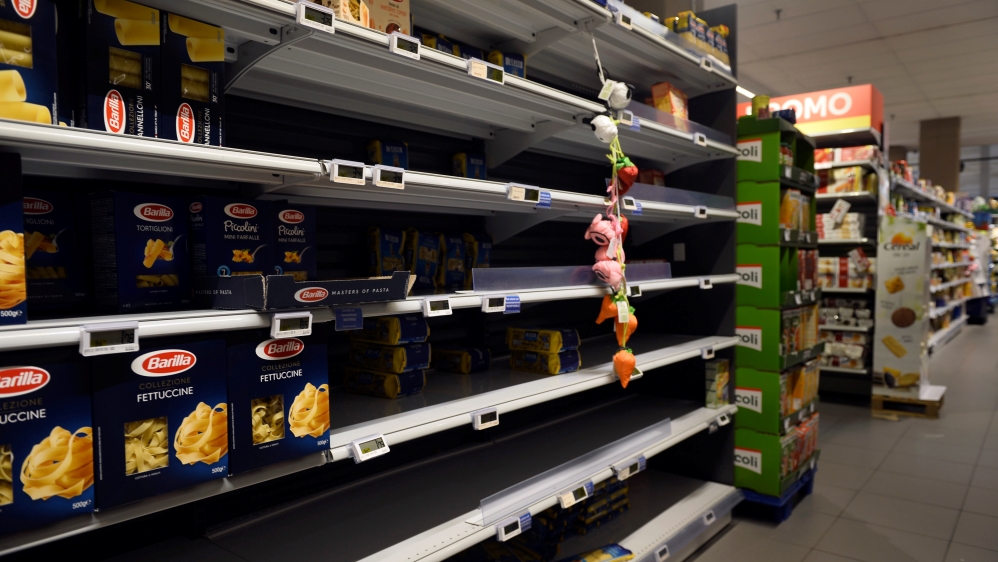Toilet paper, canned food: What explains coronavirus panic buying
As the epidemic spreads across the globe, people have been seen rushing to supermarkets to buy ‘essentials’ in bulk.

First it was the masks, then hand sanitisers. Now it seems the novel coronavirus outbreak has people rushing to stock up, among other things, an essential item: toilet paper.
Shelves have been emptied across the world. In Australia, a newspaper helpfully printed out an extra eight pages as a “backup loo roll”. Fights have broken out, trolleys piled high, and across the United States, Canada and the United Kingdom, most supermarkets imposed a cap to limit the number of rolls a person could buy.
Keep reading
list of 3 itemsCoronavirus: Which countries have confirmed cases?
Coronavirus: All you need to know about symptoms and risks
Dubbed #ToiletPaperPanic and #ToiletPaperApocalypse online, there is no shortage of videos capturing the mass hysteria that has swept up globally as shelves are cleared. Canned goods, water bottles and pasta shelves have similarly been emptied out.
So, why are we seeing panic buying across the globe?
“Panic buying and hoarding of supplies is obviously not desirable, but it’s understandable, particularly when people see images of cities, regions and even whole countries in lockdown,” Michael Baker, professor of public health at the University of Otago in Wellington, New Zealand, told Al Jazeera.
While panic buying was not seen in response to the most recent influenza pandemic in 2009, Baker said the ongoing crisis is similar to a behavioural response during a natural disaster.
“The difference this time is that people now see COVID-19 as a real threat, one that will last for months, and they may not have confidence in the authorities to contain it.”

Insufficient information on the new coronavirus is also playing a factor in people’s response, while current measures taken by the authorities do not seem to have reassured the masses.
Sense of control
“We’re poor at learning and good at forgetting. No one alive today has seen a global pandemic of this seriousness. Current measures to manage this pandemic are not nearly enough in most countries,” Baker said.
“We are now seeing the world splitting into those countries which are containing this pandemic, notably China, Singapore and South Korea, and those which are not.”
Anxiety over return to a sense of control is another factor behind the widespread panic, said experts.
“We don’t know how long it will last, we don’t know much about the virus, it’s something new and we are learning something new about it,” Dimitrios Tsivrikos, consumer and business psychologist at the University College London, told Al Jazeera.
“Consumers are trying to gain control and panic buying is essentially our attempt to be in control of a situation. It’s quite important to feel that at least we are doing something, we are being proactive and panic buying is exactly that,” he said.
Tsivrikos said consumers are also in a position where they are receiving global news, looking at other countries, for instance Italy on lockdown, and comparing it to local news and directions they are getting, further creating a sense of added uncertainty.
But is our increasing connectivity and heightened awareness a good thing, or is it feeding increasing anxiety among the people?
Social media
“While established media organisations might be trying to cover the outbreak in a measured way, that’s no longer the only source we consume information from. Certain claims read online might aggravate the anxiety. While social media is a great place for entertainment, consumers need to be wary of getting their news from there,” Tsivrikos said.
Social media’s impact is a mixed bag, Baker added. “It’s good at connecting people and giving them a voice, but it also dilutes messages from key health agencies with many unqualified voices. Now, everyone’s an expert.”
“If you think about it, people are walking into the markets, they are looking for bulk, large volume items that last for longer. They want to grab the largest possible items – toilet paper is one of those,” said Tsivrikos.
“That, added to the fact that it is low-value, means you don’t need to think about it much. You tell yourself that at some point I’ll have to use it, so I might as well get loads of it, especially as the duration is uncertain.”
While panic buying may give consumers a sense of control and help them manage anxiety, experts said it could also disrupt the supply chain.
“We don’t have an unlimited supply, so if we’re buying things disproportionately, others who are in immediate need of that item won’t be able to find it,” said Tsivrikos.
Most patients recover
|
|
On Wednesday, the World Health Organization declared the coronavirus outbreak a pandemic, warning that while it had “alarming levels of spread and severity”, it was also witnessing “alarming levels of inaction” by the authorities.
“Technically, COVID-19 has been a pandemic for several weeks,” professor of public health, Michael Baker, told Al Jazeera. “WHO calling it one now makes no difference.”
Baker said the WHO’s January 30 announcement, declaring coronavirus PHEIC (Public Health Emergency of International Concern) essentially meant it was a global health emergency.
More than 132,000 people have now been infected worldwide and the death toll is close to 5,000.
However, the WHO said a vast majority of coronavirus patients recover: those with mild illnesses in two weeks, while those with more severe symptoms may require three to six weeks.
According to Johns Hopkins University, nearly 66,000 coronavirus patients have recovered so far.